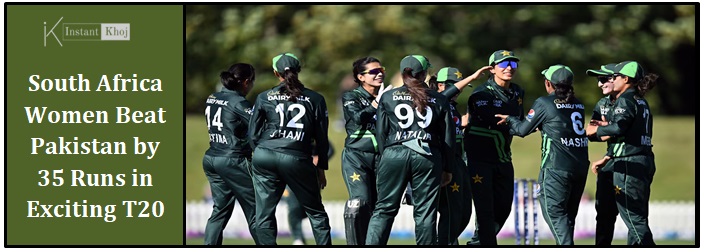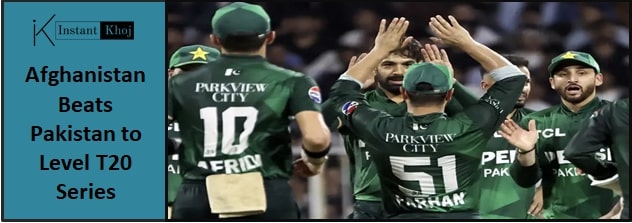The ICC Women’s T20 World Cup 2025 witnessed a compelling contest as South Africa Women secured a commanding 35-run victory over Pakistan Women at the picturesque Newlands Cricket Groundin Cape Town. With a blend of solid batting, tactical bowling, and sharp fielding, South Africa showcased their growing strength in women’s cricket. Pakistan, despite spirited efforts, fell short in their chase, highlighting areas for growth and adaptation in the high-pressure tournament environment.
Match Snapshot: Key Stats and Highlights
Category | Details |
|---|---|
| Result | South Africa Women won by 35 runs |
| South Africa’s Total | 160/6 in 20 overs |
| Pakistan’s Chase | 125/9 in 20 overs |
| Venue | Newlands Cricket Ground, Cape Town |
| Top Performers | Laura Wolvaardt (55 off 43), Ayabonga Khaka (3/21), Aliya Riaz (44 off 37) |
| Date | September 16, 2025 |
| Tournament | ICC Women’s T20 World Cup 2025 |
First Innings: South Africa Build a Competitive Total with Patience and Power
Winning the toss and electing to bat first, South Africa Women set out with the clear intention of posting a challenging total on a pitch known to assist both batters and bowlers at different phases.
-
Solid Start by the Top Order: Laura Wolvaardt, one of South Africa’s most reliable batters, anchored the innings with poise and precision. She scored a well-timed 55 runs off 43 balls, combining watchful defense with timely aggression. Her innings was highlighted by crisp drives, controlled pulls, and clever placement that constantly pressured the Pakistan bowlers.
-
Support from Middle Order: Tazmin Brits and Marizanne Kapp played vital roles by rotating the strike effectively and keeping the scoreboard ticking. Brits’ calm approach helped maintain momentum while Kapp’s powerful hitting during the middle overs ensured South Africa remained ahead on the run rate.
-
Late Surge in Death Overs: Ayabonga Khaka’s quick-fire cameo in the last five overs proved pivotal. Her aggressive hitting accelerated the innings, adding crucial boundaries and sixes. Khaka’s ability to switch gears and finish strong enabled South Africa to cross the 160-run mark, which would later prove challenging for Pakistan’s chase.
-
Bowling Challenges for Pakistan: Despite some tactical bowling changes, Pakistan struggled to contain the run flow, especially in the powerplay and death overs. Extras and occasional loose deliveries also contributed to South Africa’s final competitive total.
Tactical Approach: Balance Between Patience and Aggression
South Africa’s batting approach displayed remarkable balance:
-
Building Partnerships: The openers focused on steady accumulation, ensuring wickets were not lost cheaply. This set a platform for the middle and lower order to express themselves freely.
-
Rotation of Strike: Players prioritized rotating the strike through singles and twos, ensuring the bowling side did not settle into a rhythm.
-
Finishing Strong: The late overs saw an injection of power hitting, a vital aspect of T20 cricket, which South Africa executed flawlessly.
On the other hand, Pakistan’s bowling strategy aimed to disrupt these plans through:
-
Bowling Variations: Mix of spin and pace to create uncertainty.
-
Field Placements: Aggressive fields in the powerplay to seek early wickets.
However, execution was inconsistent, with key overs leaking runs, especially in the latter half.
Second Innings: Pakistan Women’s Chase Under Pressure Ends in Disappointment
Pakistan Women began their chase with clear intent but soon found themselves under pressure due to early wickets.
-
Early Setbacks: Losing wickets in the powerplay curtailed their ability to build momentum. The openers struggled to find form against South Africa’s disciplined bowling attack.
-
Aliya Riaz’s Resistance: Middle-order batter Aliya Riaz stood out with a composed 44 runs off 37 balls. Her innings blended patience with moments of aggression, providing Pakistan with hope of a chase.
-
Bowling Brilliance from South Africa: Ayabonga Khaka was the standout bowler, claiming 3 crucial wickets for just 21 runs. Her disciplined line and length, combined with subtle variations, constantly challenged the batters.
-
Support from Shabnim Ismail: The pace spearhead contributed with important breakthroughs, keeping Pakistan’s chase under tight control.
-
Lower-Order Fight: Despite a spirited resistance from the lower order, led by players like Fatima Sana and Nashra Sandhu, Pakistan couldn’t keep up with the required run rate. Tight fielding and consistent bowling from South Africa prevented any significant partnerships.
-
Closing Stages: Pakistan’s innings ended at 125 for 9 wickets, 35 runs short of the target, reflecting both South Africa’s dominance and Pakistan’s struggle to convert starts into match-winning performances.
Player Highlights: Defining Moments and Key Contributions
-
Laura Wolvaardt (South Africa): Her captain’s knock was a blend of technique and temperament, setting the foundation for a competitive total. Her ability to rotate strike and find boundaries kept the scoreboard moving.
-
Ayabonga Khaka (South Africa): The standout all-rounder of the match, Khaka’s three wickets at a crucial juncture and quick runs at the death were match-winning contributions.
-
Aliya Riaz (Pakistan): A lone warrior in Pakistan’s batting lineup, Riaz’s innings was notable for its balance and grit, showcasing her importance to the team.
-
Shabnim Ismail (South Africa): Her pace and swing troubled the Pakistani batters, earning key wickets and applying pressure throughout the innings.
Match Flow: Key Phases and Turning Points
Phase | Key Moment |
|---|---|
| Powerplay | South Africa’s steady start, scoring 45 runs, setting tone. |
| Middle Overs | Consolidation and wicket-taking by Pakistan’s bowlers. |
| Death Overs | Khaka’s explosive hitting takes total past 160. |
| Chase Start | Early wickets put Pakistan under immediate pressure. |
| Mid-Chase | Riaz stabilizes innings but wickets fall regularly. |
| Final Overs | South Africa bowlers tighten, Pakistan falls short. |
What This Win Means
For South Africa Women:
-
The victory significantly boosts South Africa’s confidence and net run rate in the group.
-
It reinforces their status as a strong contender in the ICC Women’s T20 World Cup.
-
Shows a balanced team performance with contributions from multiple players.
-
Builds momentum for the upcoming fixtures in the tournament.
For Pakistan Women:
-
The loss highlights areas needing improvement, especially in building partnerships and handling pressure chases.
-
Demonstrates the team’s potential with players like Aliya Riaz showing promise.
-
Emphasizes the need for better execution in death overs and strategic shot selection.
-
Provides valuable lessons to adapt and grow in future games.
Coach’s Corner: Reflections and Future Directions
-
South Africa’s Coach: Praised the team’s composure and adaptability under pressure. Emphasized the importance of building innings patiently and finishing strongly, which the team executed well. The bowling unit’s discipline was also highlighted as a key to victory.
-
Pakistan’s Coach: Acknowledged the fighting spirit and resilience but stressed the need for better game management, especially during chases. Focus will be on improving batting depth, partnership building, and mental toughness in crunch moments.
The Venue: Newlands Cricket Ground
-
Known for its picturesque setting against the backdrop of Table Mountain, Newlands offers a balanced pitch favoring both batsmen and bowlers.
-
The venue often witnesses competitive matches where strategic depth plays a crucial role.
-
The crowd support for both teams added energy and intensity to the encounter.
Historical Context and Rivalry
-
South Africa and Pakistan women have faced each other in multiple ICC events, with South Africa generally holding a slight edge.
-
This match adds another chapter to their growing rivalry, reflecting the rise in competitiveness in women’s international cricket.
-
Both teams continue to develop rapidly, making such contests exciting for fans and stakeholders alike.
Final Thoughts
The South Africa Women vs Pakistan Women clash was a testament to the evolving landscape of women’s cricket. South Africa’s ability to build a challenging total and execute a disciplined bowling plan proved decisive. Pakistan’s spirited effort, led by Aliya Riaz, showed promise but fell short of the target.
This match not only provided thrilling cricket but also valuable insights into the tactical depth and mental resilience required at the highest level. As the tournament progresses, both teams will look to learn from this encounter, with South Africa aiming to maintain their momentum and Pakistan striving to overcome challenges and improve performance.




